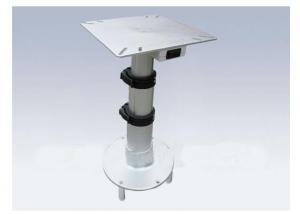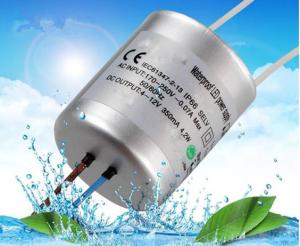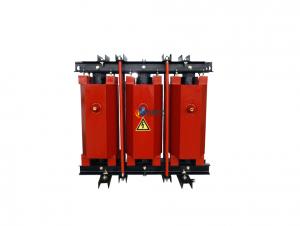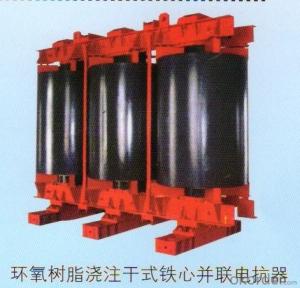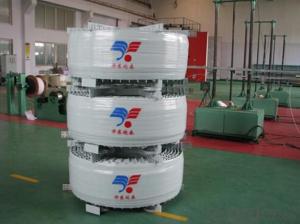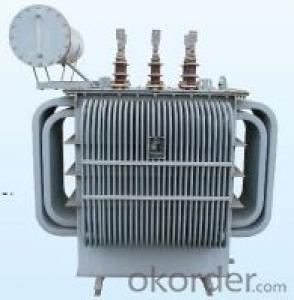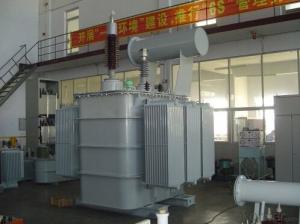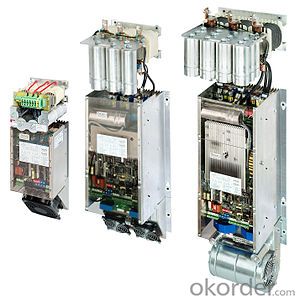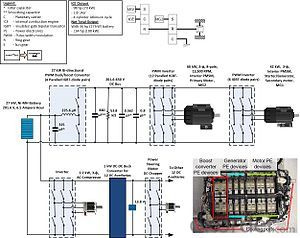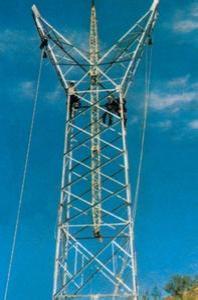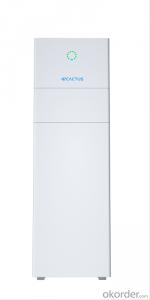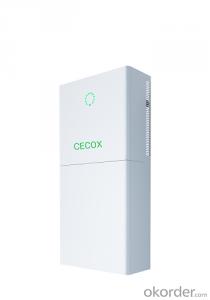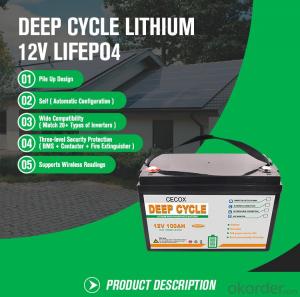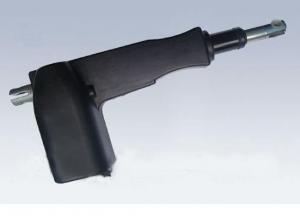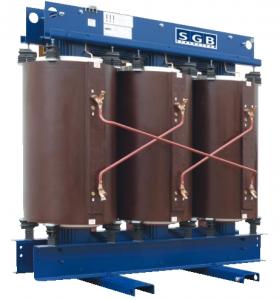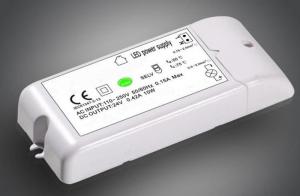HAI YAN Variable-frequency drive-lx2000-01
- Loading Port:
- Ningbo
- Payment Terms:
- TT OR LC
- Min Order Qty:
- 1 unit
- Supply Capability:
- 10 unit/month
OKorder Service Pledge
OKorder Financial Service
You Might Also Like
AC line harmonics
It is also possible to replace the standard diode-bridge rectifier with a bi-directional IGBT switching device bridge mirroring the standard inverter which uses IGBT switching device output to the motor. Such rectifiers are referred to by various designations including active infeed converter (AIC), active rectifier, IGBT supply unit (ISU), active front end (AFE), or four-quadrant operation. With PWM control and a suitable input reactor, an AFE's AC line current waveform can be nearly sinusoidal. AFE inherently regenerates energy in four-quadrant mode from the DC side to the AC grid. Thus, no braking resistor is needed, and the efficiency of the drive is improved if the drive is frequently required to brake the motor.
Two other harmonics mitigation techniques exploit use of passive or active filters connected to a common bus with at least one VFD branch load on the bus. Passive filters involve the design of one or more low-pass LC filter traps, each trap being tuned as required to a harmonic frequency (5th, 7th, 11th, 13th, . . . kq+/-1, where k=integer, q=pulse number of converter).
It is very common practice for power companies or their customers to impose harmonic distortion limits based on IEC or IEEE standards. For example, IEEE Standard 519 limits at the customer's connection point call for the maximum individual frequency voltage harmonic to be no more than 3% of the fundamental and call for the voltage total harmonic distortion (THD) to be no more than 5% for a general AC power supply system.
Long-lead effects
The carrier-frequency pulsed output voltage of a PWM VFD causes rapid rise times in these pulses, the transmission line effects of which must be considered. Since the transmission-line impedance of the cable and motor are different, pulses tend to reflect back from the motor terminals into the cable. The resulting voltages can produce overvoltages equal to twice the DC bus voltage or up to 3.1 times the rated line voltage for long cable runs, putting high stress on the cable and motor windings, and eventual insulation failure. Note that standards for three-phase motors rated 230 V or less adequately protect against such long-lead overvoltages. On 460 V or 575 V systems and inverters with 3rd-generation 0.1-microsecond-rise-time IGBTs, the maximum recommended cable distance between VFD and motor is about 50 m or 150 feet. Solutions to overvoltages caused by long lead lengths include minimizing cable distance, lowering carrier frequency, installing dV/dt filters, using inverter-duty-rated motors (that are rated 600 V to withstand pulse trains with rise time less than or equal to 0.1 microsecond, of 1,600 V peak magnitude), and installing LCR low-pass sine wave filters. Regarding lowering of carrier frequency, note that audible noise is noticeably increased for carrier frequencies less than about 6 kHz and is most noticeable at about 3 kHz. Note also that selection of optimum PWM carrier frequency for AC drives involves balancing noise, heat, motor insulation stress, common-mode voltage-induced motor bearing current damage, smooth motor operation, and other factors. Further harmonics attenuation can be obtained by using an LCR low-pass sine wave filter or dV/dt filter.
Dynamic braking
See also: Dynamic braking and Regenerative braking
Torque generated by the drive causes the induction motor to run at synchronous speed less the slip. If the load drives the motor faster than synchronous speed, the motor acts as a generator, converting mechanical power back to electrical power. This power is returned to the drive's DC link element (capacitor or reactor). A DC-link-connected electronic power switch or braking DC chopper controls dissipation of this power as heat in a set of resistors. Cooling fans may be used to prevent resistor overheating.
Dynamic braking wastes braking energy by transforming it to heat. By contrast, regenerative drives recover braking energy by injecting this energy into the AC line. The capital cost of regenerative drives is, however, relatively high.
Regenerative drives
Line regenerative variable frequency drives, showing capacitors (top cylinders) and inductors attached, which filter the regenerated power.
Simplified Drive Schematic for a Popular EHV
Regenerative AC drives have the capacity to recover the braking energy of a load moving faster than the designated motor speed (an overhauling load) and return it to the power system.
Cycloconverter, Scherbius, matrix, CSI, and LCI drives inherently allow return of energy from the load to the line, while voltage-source inverters require an additional converter to return energy to the supply.
Regeneration is useful in VFDs only where the value of the recovered energy is large compared to the extra cost of a regenerative system, and if the system requires frequent braking and starting. Regenerative VFDs are widely used where speed control of overhauling loads is required.
Some examples:
Conveyor belt drives for manufacturing, which stop every few minutes. While stopped, parts are assembled correctly; once that is done, the belt moves on.
A crane, where the hoist motor stops and reverses frequently, and braking is required to slow the load during lowering.
Plug-in and hybrid electric vehicles of all types
- Q:considering that he is specialised in power engineering or does he administers them.
- Turbine engines (either steam of fuel-injected) are mechanical parts and not electrical parts. A electrical engineer will be working on the generator that is attached to this systems. They will also work on the transmission of that power (Transformers and all that good stuff!).
- Q:1. diode2. converter3. transformer 4. mercury-arc rectifierpl provide with explanation
- obviously (3) transformer All the others allow current in only one direction. And i assume the converter is an AC to DC converter.
- Q:Do electronic engineers make audio equipment like headphones, amps, and speakers? And do you learn this in engineering schools in college?
- Yes and No. Although all electronic engineers should have the basic knowledge, you can nowadays find that hardware engineers tend to specialise in either digital or analog electronics. A typical digital hardware engineer may struggle, while an analog engineer certainly can design audio equipment. I doubt that electrical engineers could do the job, they are specialised in power distribution.
- Q:I am currently studying electrical engineering in college but Im considering maybe teaching math for a while. But I wanted to ask what the daily routine is like for an electrical engineer at workThank you
- I am an electrical engineer at the university of texas at austin and I recently interned at L3 as an electrical engineer working with hardware. Basically from what Ive done you really work with testing electrical equipment making sure it works correctly. I worked a lot with multisim, matlab, and other programing/testing devices. You also get to install hardware ocassionally. But most of the time I followed around my mentor and learned what the day to day job required. Had to get a security clearance though.
- Q:I have a school project (Construction management) that involves the estimating of the electrical cost for a building addition. I can do the fixture counts, equipment hook ups, box counts, switches and etc. I cant figure out how much wiring would be involved. from the blueprints, is there a way to measure (estimate) the lf of wiring? this is a school building so there are mostly medsize room and hallways. any help would be great. I remember something about the homerun count from when i was a laborer, but could i figure 1 line around the room with a line for fixtures or something like that. doesnt have to be perfect by any means.
- One way to go would be to identify the circuits in each room. Measure distance between outlets switches , add 12 for each outlet or fixture each 90deg turn if wire is to be run in conduit. If you have some idea of route wiring will take, account for going up over cielings or under floors to the home run to the service panel for each circuit , allow for a 6' tail at breaker location then add 10%. Assuming everything will take (or might be required to take ) perimeter routes w/ 90deg turns dressing the conduit on walls or racks you should be be safe. Some est runs will be long some short , but it evens out. Might be a good idea to show how you arrived at estimate on your worksheet. Might not be the only way to estimate , but it shows you gave it some thought. Best regards
- Q:If I bring my laptop (North America 60Hz) and use it in Europe (50Hz), would it work properly?If so, does that mean my laptop/power cord has a frequency converter?
- my laptop has an internal battery, so it can operate with no outside voltage at all. The power adaptor is rated 100-240 volts 50/60 cycle input with no adjustments needed. such ratings are very common for this type of equipment. what will be needed is converters for the blade type plug to the kind in use for the country you are visiting. If you are going to be in Europe for an extended period, you should be able to get the proper line cord for the power adaptor from the computer manufacterer.
- Q:At around 11:30PM on January 23rd, 2007 as I was typing on my PC the lights began to flicker and my computer began turning on and off. The lights then became extremely bright followed by a booms outside then the lights dimmed so low it looked as if they were about to burn out. The house phone was on began to cut out and made a loud screeching sound and thensilence.These strange events lasted for nearly 15 minutes when a knock at the front door got my attention. It was a fireman informing me to shut off my computer if I had one because of electrical problems that were occurring in the area. I immediately did so.It was not until the morning I discovered that my two TV's, all three cordless phones, a microwave, two alarm clocks, my entire computer, VCR/DVD, DVR/Cable Box had all been destroyed due to the massive power surge they endured. After surveying each and every unit I learned that all appliances in every apartment was damaged or destroyed.Who is to blame for this?
- In many states, the local electrical utility is responsible for delivering proper power to their customers and when they don't, they can be required to replace any damaged equipment. They get to sue people who cause them problems (like an accident that damages their equipment, which then damaged your equipment). You should contact your local utility to see if they will voluntarily replace your losses, and if not, then contact your state power utility regulators to see if they can be compelled to. You, as a public utilities customer, should not be not required to foresee all of the possible power problems that might occur -- that's the utility's job. You probably ought to get a copy of any police or fire report of the incident that led to the fireman knocking on your door. That would probably help your case when you file a claim with the utility or state regulators.
- Q:I am just a few classes away from getting my Associates in Electrical Engineering. I currently have a Diploma in Industrial Electricity and have been working in industrial maintenance for 12 yrs. and am currently an electrical technician (10 yrs. multi-skilled and the last 2 yrs. strictly electrical due to a job change). I have returned to school to get my AAS in EE, so I would really like to know what possibilities I could expect.
- You can get a job as an electronic engineering technicians. You help design, develop, test, and manufacture electrical and electronic equipment such as communication equipment, medical monitoring devices, navigational equipment, and computers. You may work in product evaluation and testing, using measuring and diagnostic devices to adjust, test, and repair equipment. Median annual wages of wage and salary electrical and electronic engineering technicians were $53,240 in May 2008. The middle 50 percent earned between $41,550 and $64,120. The lowest 10 percent earned less than $32,490, and the highest 10 percent earned more than $78,560. Median annual earnings in the industries employing the largest numbers of electrical and electronic engineering technicians were:
- Q:I work on a plant where my workers have to trouble shoot low DC control voltage circuits besides high voltages ac running machines which are operated by inverters as well as from direct ac powerNeed a document or some tips to prevent electrical shocks and for electrician guidance
- Work only in dry environments. No water on the floor. Plug AC powered test equipment into a GFCI protected circuit. Really no safety issues on DC voltages under 50V. Only handle electrical leads with one hand. Keep the other in your pocket. Rubber mats to stand on. Rubber gloves worn inside leather gloves Face shield and arc-flash rated clothing when working on anything over 50VAC.
- Q:I am gonna graduate in may with a 2 year degree which would make me a Electronics tech. I already was offered a job with Intell and i plan to work there while i get my bachlor. Is there i difference in the 2? and also Intell offered me 52k to start as a tech, is that good? and how much can i expect to make once i get my 4 year degree? thx
- There really isn't a great deal of difference. In common usage 'Electrical Engineering' tends to imply high power systems while 'Electronics Engineering' implies lower power (signal processing) levels. But they're really about the same. And 52K is a fairly good salary. The average young engineer out of college makes about 50K to 60K. I believe the median for EE's today is around 70K to 90K. Doug
1. Manufacturer Overview |
|
|---|---|
| Location | |
| Year Established | |
| Annual Output Value | |
| Main Markets | |
| Company Certifications | |
2. Manufacturer Certificates |
|
|---|---|
| a) Certification Name | |
| Range | |
| Reference | |
| Validity Period | |
3. Manufacturer Capability |
|
|---|---|
| a)Trade Capacity | |
| Nearest Port | |
| Export Percentage | |
| No.of Employees in Trade Department | |
| Language Spoken: | |
| b)Factory Information | |
| Factory Size: | |
| No. of Production Lines | |
| Contract Manufacturing | |
| Product Price Range | |
Send your message to us
HAI YAN Variable-frequency drive-lx2000-01
- Loading Port:
- Ningbo
- Payment Terms:
- TT OR LC
- Min Order Qty:
- 1 unit
- Supply Capability:
- 10 unit/month
OKorder Service Pledge
OKorder Financial Service
Similar products
New products
Hot products




